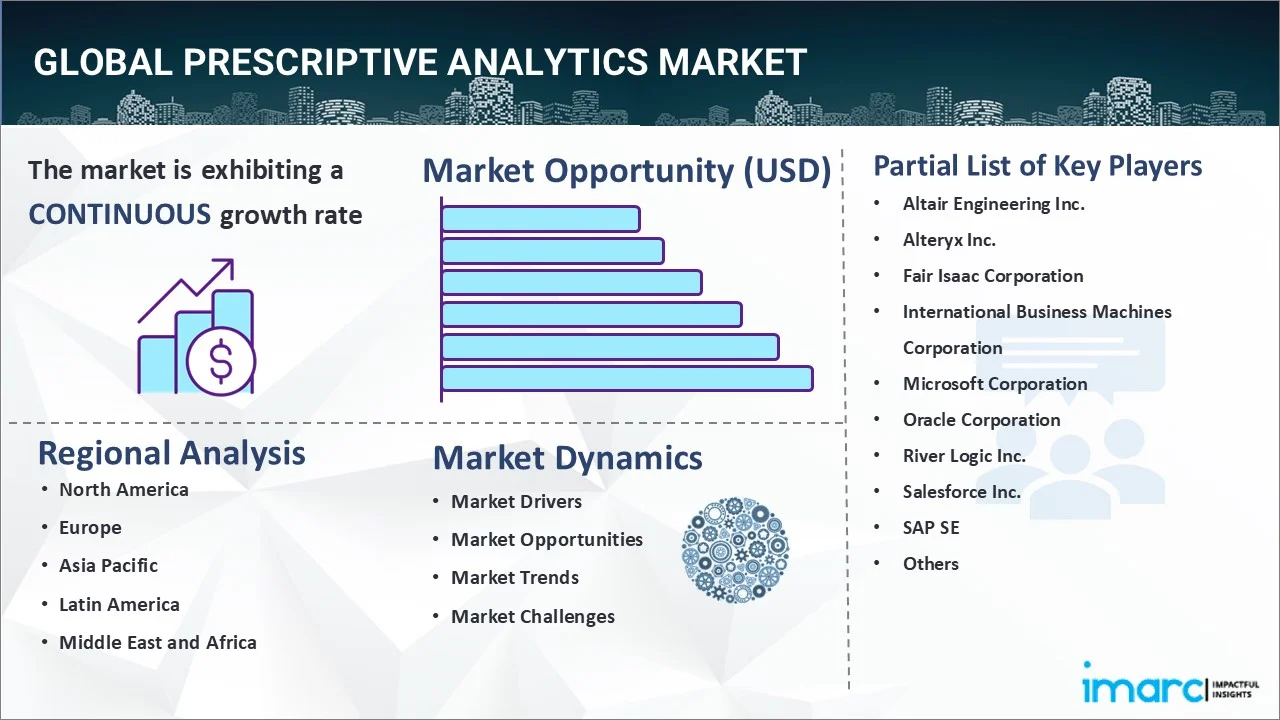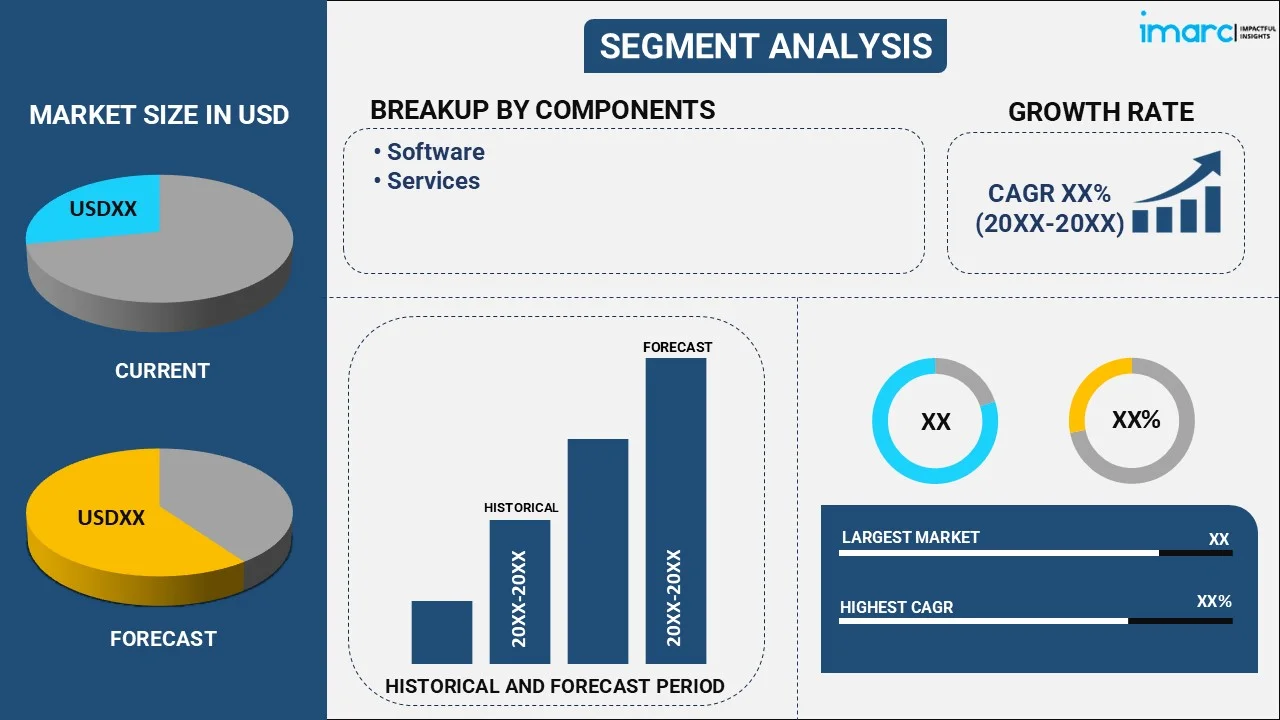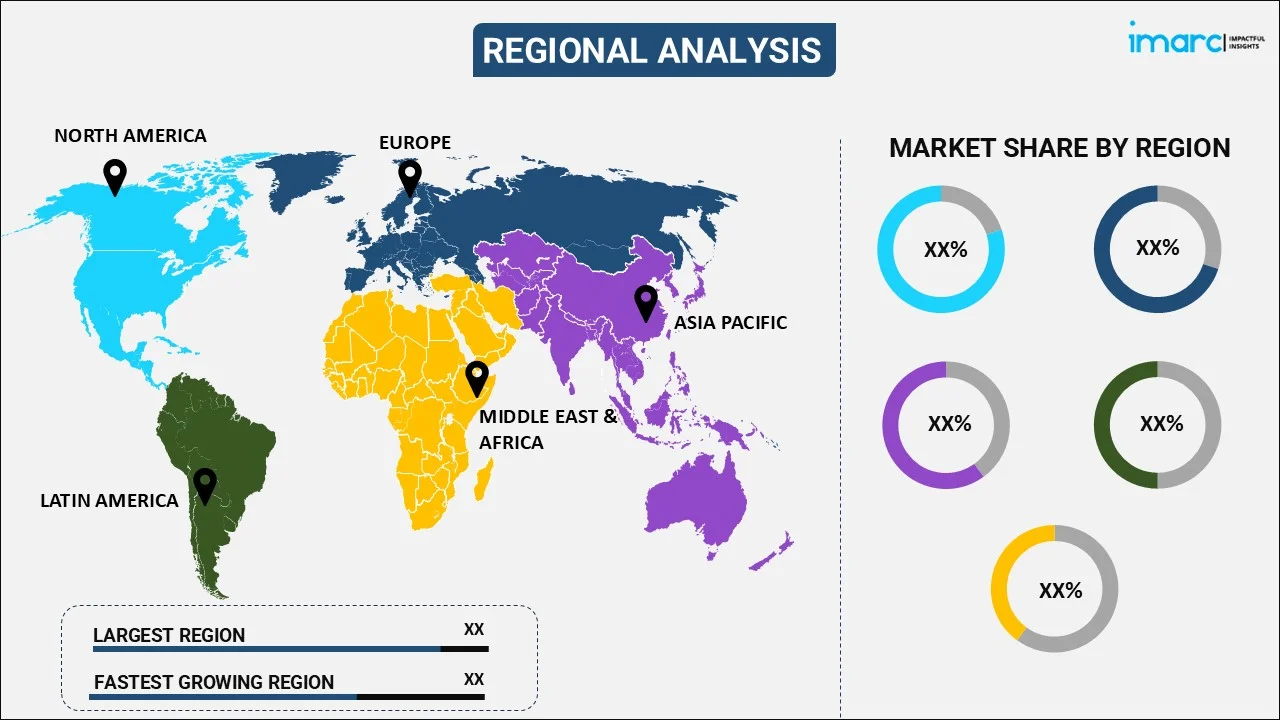
Prescriptive Analytics Market Report by Component (Software, Services), Deployment Mode (On-premises, Cloud-based), Business Function (Operations, Sales, Marketing, Finance, Human Resources), Organization Size (Small and Medium-sized Enterprises, Large Enterprises), Industry Vertical (BFSI, Healthcare, IT and Telecommunications, Retail, Media and Entertainment, Manufacturing, Energy and Utilities, Transportation and Logistics, Government, and Others), and Region 2025-2033
Prescriptive Analytics Market Size & Share:
The global prescriptive analytics market size reached USD 6.9 Billion in 2024. Looking forward, IMARC Group expects the market to reach USD 32.4 Billion by 2033, exhibiting a growth rate (CAGR) of 17.77% during 2025-2033. Expanding proliferation of data, the rising number of cybercrimes, and the increasing demand from healthcare and BFSI sectors represent some of the key factors driving the market. At present, North America holds the largest prescriptive analytics market share, driven by strong focus on data-driven decision-making and presence of major technology companies.
|
Report Attribute
|
Key Statistics
|
|---|---|
|
Base Year
|
2024
|
|
Forecast Years
|
2025-2033
|
|
Historical Years
|
2019-2024
|
|
Market Size in 2024
|
USD 6.9 Billion |
|
Market Forecast in 2033
|
USD 32.4 Billion |
| Market Growth Rate 2025-2033 | 17.77% |
Prescriptive analytics employs machine learning (ML), artificial intelligence (AI), and statistical algorithms to analyze massive amounts of data and provide recommended courses of action. It uses historical and real-time data and considers different variables, constraints, and objectives to simulate various scenarios and determine the best course of action. It is considered a valuable tool in businesses to optimize operations, make data-driven strategic decisions, and cause better outcomes. As a result, it finds a wide range of applications across numerous industries, such as healthcare, finance, supply chain management, and marketing.
With the exponentially increasing amount of data available, businesses across the globe are looking for solutions, such as prescriptive analytics, that can leverage collected information to drive real business value. Besides this, prescriptive analytics provides businesses with comprehensive data analysis to identify data-driven strategic decisions, which, in turn, is positively impacting the market growth. Moreover, rising incidences of cybercrimes, coupled with the growing need to preclude fraudulent activities, are presenting remunerative growth opportunities for the market. Furthermore, the shifting preference for cloud platforms, development of cloud data warehouses, and significant technological advancements in terms of user-friendliness, accuracy, and security are creating a favorable outlook for the market.

Prescriptive Analytics Market Trends:
Increasing Adoption in BFSI and Healthcare Industries
The largescale adoption of prescriptive analytics in the banking, financial services, and insurance (BFSI) sector to detect and flag frauds, alert the bank, and provide recommended courses of action, is fueling the market growth. In addition, the increasing demand across the healthcare industry to assess pre-existing patient conditions, determine their risk for developing future conditions, and implement specific preventative treatment plans is contributing to the market growth. Concurrently, prescriptive analytics is used to develop personalized treatment plans for patients and provide improved and quality patient care, which is aiding in market expansion.
Surging Demand of Real-time Data Accessibility
Data-driven decision-making has increasingly become an essential requirement for businesses focusing on expansion. Real-time accessibility of data supports businesses to analyze and process data for generating frequent strategies for performance improvements and attaining a competitive edge. Companies are increasingly harnessing the potential of analytical tools and business intelligence to drive strategic decision-making in real-time. Prescriptive analytics deploys technologies, including AI and ML for identifying and recommending a set of actions to administer future scenarios. For instance, Amazon implements user data inputs for recommending similar products for shoppers based on the original purchase.
Integration with IoT Technology
The rising integration of prescriptive analytics tools with technologies including IoT and edge computing is transforming the market dynamics. As IoT-driven solutions penetrate across various industries, they generate enormous amounts of real-time data for analyzing and strategic decision-making. Prescriptive analytics in integration with IoT, enables businesses to make instant, data-driven decisions for optimizing operations, reducing downtime, and improving overall efficiency. For instance, in smart manufacturing, prescriptive analytics helps predict failures in equipment and suggests maintenance actions beforehand, thereby limiting production disruptions. Further, in the energy sector, it helps optimize energy usage and alleviate waste, resulting in environmental benefits and cost savings.
Key Market Segmentation:
IMARC Group provides an analysis of the key trends in each sub-segment of the global prescriptive analytics market report, along with forecasts at the global, regional and country level from 2025-2033. Our report has categorized the market based on component, deployment mode, business function, organization size and industry vertical.
Component Insights:

- Software
- Services
The prescriptive analytics market research report has provided a detailed breakup and analysis of the market based on the component. This includes software and services. According to the report, software represented the largest segment.
Deployment Mode Insights:
- On-premises
- Cloud-based
A detailed breakup and analysis of the prescriptive analytics market based on the deployment mode has also been provided in the report. This includes on-premises and cloud-based. According to the report, on-premises accounted for the largest market share.
Business Function Insights:
- Operations
- Sales
- Marketing
- Finance
- Human Resources
The report has provided a detailed breakup and analysis of the prescriptive analytics market based on the business function. This includes operations, sales, marketing, finance, and human resources.
Organization Size Insights:
- Small and Medium-sized Enterprises
- Large Enterprises
A detailed breakup and analysis of the prescriptive analytics market based on the organization size has also been provided in the report. This includes small and medium-sized enterprises, and large enterprises.
Industry Vertical Insights:
- BFSI
- Healthcare
- IT and Telecommunications
- Retail
- Media and Entertainment
- Manufacturing
- Energy and Utilities
- Transportation and Logistics
- Government
- Others
The report has provided a detailed breakup and analysis of the prescriptive analytics market based on the industry vertical. This includes BFSI, healthcare, IT and telecommunications, retail, media and entertainment, manufacturing, energy and utilities, transportation and logistics, government, and others. According to the report, BFSI represented the largest segment.
Regional Insights:

- North America
- United States
- Canada
- Asia-Pacific
- China
- Japan
- India
- South Korea
- Australia
- Indonesia
- Others
- Europe
- Germany
- France
- United Kingdom
- Italy
- Spain
- Russia
- Others
- Latin America
- Brazil
- Mexico
- Others
- Middle East and Africa
The report has also provided a comprehensive analysis of all the major regional markets, which include North America (the United States and Canada); Asia Pacific (China, Japan, India, South Korea, Australia, Indonesia, and others); Europe (Germany, France, the United Kingdom, Italy, Spain, Russia, and others); Latin America (Brazil, Mexico, and others); and the Middle East and Africa. According to the report, North America was the largest market for prescriptive analytics. Some of the factors driving the North America prescriptive analytics market included the massive generation of data, escalating concerns regarding cyber security, and widespread product adoption across numerous industries.
Competitive Landscape:
The report has also provided a comprehensive analysis of the competitive landscape in the global prescriptive analytics market. Competitive analysis such as market structure, market share by key players, player positioning, top winning strategies, competitive dashboard, and company evaluation quadrant has been covered in the report. Also, detailed profiles of all major companies have been provided. Some of the companies covered include Altair Engineering Inc., Alteryx Inc., Fair Isaac Corporation, International Business Machines Corporation, Microsoft Corporation, Oracle Corporation, River Logic Inc., Salesforce Inc., SAP SE, SAS Institute Inc., Teradata Corporation, TIBCO Software Inc. and Zebra Technologies Corporation. Kindly note that this only represents a partial list of companies, and the complete list has been provided in the report.
Report Coverage:
| Report Features | Details |
|---|---|
| Base Year of the Analysis | 2024 |
| Historical Period | 2019-2024 |
| Forecast Period | 2025-2033 |
| Units | Billion USD |
| Segment Coverage | Component, Deployment Mode, Business Function, Organization Size, Industry Vertical, Region |
| Region Covered | Asia Pacific, Europe, North America, Latin America, Middle East and Africa |
| Countries Covered | United States, Canada, Germany, France, United Kingdom, Italy, Spain, Russia, China, Japan, India, South Korea, Australia, Indonesia, Brazil, Mexico |
| Companies Covered | Altair Engineering Inc., Alteryx Inc., Fair Isaac Corporation, International Business Machines Corporation, Microsoft Corporation, Oracle Corporation, River Logic Inc., Salesforce Inc., SAP SE, SAS Institute Inc., Teradata Corporation, TIBCO Software Inc., Zebra Technologies Corporation. |
| Customization Scope | 10% Free Customization |
| Post-Sale Analyst Support | 10-12 Weeks |
| Delivery Format | PDF and Excel through Email (We can also provide the editable version of the report in PPT/Word format on special request) |
Key Benefits for Stakeholders:
- IMARC’s report offers a comprehensive quantitative analysis of various market segments, historical and current market trends, market forecasts, and dynamics of the prescriptive analytics market from 2019-2033.
- The research study provides the latest information on the market drivers, challenges, and opportunities in the global prescriptive analytics market.
- The study maps the leading, as well as the fastest-growing, regional markets. It further enables stakeholders to identify the key country-level markets within each region.
- Porter's five forces analysis assists stakeholders in assessing the impact of new entrants, competitive rivalry, supplier power, buyer power, and the threat of substitution. It helps stakeholders to analyze the level of competition within the prescriptive analytics industry and its attractiveness.
- Competitive landscape allows stakeholders to understand their competitive environment and provides an insight into the current positions of key players in the market.
Key Questions Answered in This Report
The global prescriptive analytics market was valued at USD 6.9 Billion in 2024.
We expect the global prescriptive analytics market to exhibit a CAGR of 17.77% during 2025-2033.
The sudden outbreak of the COVID-19 pandemic has led to the growing adoption of prescriptive analytics to assess pre-existing conditions of patients, determine the risk for developing future conditions, and implement specific preventative treatment plans for the coronavirus infection.
The rising deployment of prescriptive analytics across the BFSI sector to detect and flag frauds, alert the bank, and provide a recommended course of action, is primarily driving the global prescriptive analytics market.
Based on the component, the global prescriptive analytics market can be categorized into software and services, where software currently exhibits clear dominance in the market.
Based on the deployment mode, the global prescriptive analytics market has been segmented into on-premises and cloud-based. Currently, on-premises hold the largest market share.
Based on the industry vertical, the global prescriptive analytics market can be bifurcated into BFSI, healthcare, IT and telecommunications, retail, media and entertainment, manufacturing, energy and utilities, transportation and logistics, government, and others. Among these, the BFSI sector accounts for the majority of the total market share.
On a regional level, the market has been classified into North America, Asia-Pacific, Europe, Latin America, and Middle East and Africa, where North America currently dominates the global market.
Some of the major players in the global prescriptive analytics market include Altair Engineering Inc., Alteryx Inc., Fair Isaac Corporation, International Business Machines Corporation, Microsoft Corporation, Oracle Corporation, River Logic Inc., Salesforce Inc., SAP SE, SAS Institute Inc., Teradata Corporation, TIBCO Software Inc., and Zebra Technologies Corporation.
Need more help?
- Speak to our experienced analysts for insights on the current market scenarios.
- Include additional segments and countries to customize the report as per your requirement.
- Gain an unparalleled competitive advantage in your domain by understanding how to utilize the report and positively impacting your operations and revenue.
- For further assistance, please connect with our analysts.
 Request Customization
Request Customization
 Speak to an Analyst
Speak to an Analyst
 Request Brochure
Request Brochure
 Inquire Before Buying
Inquire Before Buying




.webp)




.webp)












